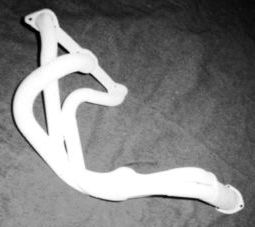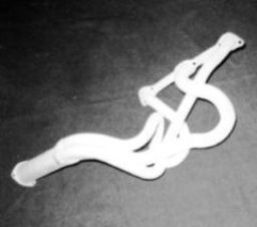| HEADER DESIGN COMMENTS - The Importance Of Header Design.
This page will be added to and updated considerably over the next several months
One of the many things that I find disturbing as I read car magazines, various automotive books and Internet discussions and watch various automobile-oriented TV programs, is the almost complete lack of discussion as as to how important header design really is (most discussion is centered more on motivating you to BUY a set of headers). This almost total lack LACK of objective discussion unfortunately seems to be interpreted by many as meaning that GOOD Header Design is of minimal importance in the overall "performance" picture. The following discussion will, I hope, convey to you not only how important GOOD Header Design is but even how often critical it can be in many situations. In any given header there are a number of design parameters that affect performance. Their presence (or absence) or to what degree they are achieved ALL have an effect on the total amount of performance gained (or lost) by the addition of a header or a change of header design. These design parameters (essentially listed by importance) are:
1. Tube Size a. "Restriction" based Header Design Theory b. "Velocity" based Header Design Theory c. Two Tube Size Error (when selecting tube sizes) 2. Tube Length 4. Collector Size (open exhaust) 5. Collector Transition Shaping
Of all the Header Design parameters that affect performance, tube size, by far, is the most important. While I still hear comments about BIGGER IS BETTER when it comes to header design, many, many times it does not prove out to work as expected. In fact, when I talk to guys that are complaining about the performance (actually, lack of) of headers they've bought elsewhere, one of the questions I find myself asking way too often is "Why did you buy headers that are so big?", (along with "Why are they so short? and "Why are they so UNequal in length?).
"Restriction" based Header Design Theory One of the most basic MISunderstandings of how headers work to improve performance is based on an assumption that headers basically improve performance by reducing restriction to exhaust flow. While true to a certain degree, this point of view - which I call the "restriction" based point of view of header design theory - not only dictates that BIGGER IS BETTER but also includes other opinions like "turns in header tubes are bad", "welds are bad", etc. In other words, anything that can be interpreted as being restrictive to flow in some manner is considered bad and must be avoided if maximum performance is to be achieved. When I first began to build headers many years ago I actually had that point of view too - for example, thinking that if I built a header simply bigger than what someone else was making, I was assured of an automatic power gain. Well, that point of view disappeared quite quickly as by 1964 I began to realize that there was no consistency in the "restriction" based header design theory. While I had been building headers for only about two years, I had already seen bigger headers slow cars down, headers that others said were "too small" work great (compared to larger headers), big headers that helped top end power but blew away bottom end and mid-range power - totally messing up street performance, etc., etc. Plus, at times I found myself quite confused as I was often watching the exact opposite of what I believed true working better! Because of the lack of consistency of my "restriction" based Header Design theories I began to realize there had to be a better way (a theory) of looking at exhaust system design - one that would not only work CONSISTENTLY when applied but also one that would deal with the "goofy" things I was seeing as well .
"Velocity" based Header Design Theory
Two Tube Size Error (when selecting tube sizes) and its horrendous effect on performance - street OR racing.
Notes for future comments:
Importance of Header Design on street driven vehicles.
"Goofy" things being done. Example: Sherman and Professor Peabody getting into their "Wayback Machine" (time travel) and visiting a Chevy dealer in 1966 to look at two different 350HP Chevrolets (a SB Nova and a BB Chevelle) where, with two engines of the same power rating, the headers available (then and now) differed by 3 tube sizes!
Many header companies copy one another leading to fellows thinking there are "standard" tube sizes for certain engines. This "standardization" ignores all the differences that can be there. Mention sending for catalogs around 1970 and almost total lack of design difference in BB Chev headers - almost all were 2" even though tests and experiences we were having showed many, many times that 2" was too large - even slowing cars down at the drag strip!
Vehicle Performance "Dynamics" - NOT being paid attention to in the : (1) Optimization of street vehicle performance relative to rpms, (2) Optimization of SCCA race car performance s (include references to data acquisition devices to develop better - more performance effective - headerr designs; (3) Optimization of Pulling Header Designs by analyzing what is ACTUALLY going on in a 300' pull and how header design is NOT even considered in most pulling vehicles (relate local puller with a 572" Big Block Chev engine in his truck that consistently beats engines as large as 640" - 70 cubic inches larger - because he pays attention to the importance of the design of his headers!)
Critical - local group of guys built a Bonneville streamliner and paid NO attention to the header design they constructed - AND, unless the car runs in a class with a "soft" record AND the reason for the car to be constructed was to set a new class record - that design error will prevent the car from EVER performing to its maximum performance potential - literally negating the thousands of dollars and thousand of hours of work spent and denying these guys the very goal they have set.
Also: E-mail us with suggestions you would like us to comment on? M0226_OKSMpfOKip:mDI
.................................................................................................................................................................................... |
|
| |||||||||||||||||||||||||||||||||||||||||||||||||||||||||||||||||||||||||||||||||||||||||||||||||||||
HEADER DESIGN COMMENTS
The Importance of Header Design.
 |  | ||||





